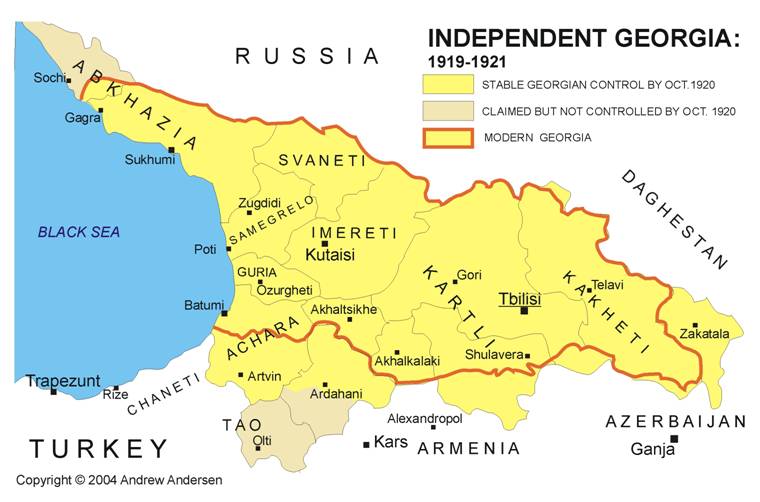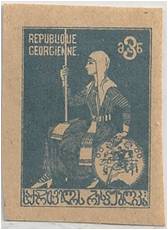ALBUM – view my Republic of Georgia (pre USSR) album
Regional Transition Chart – Transcaucasia
Fast Facts
Region: Russia Area
Group: Russian Revolution
Classification: Nation
Prior Regime: Transcaucasian Federation
Key Dates:
1918, May 26 – Declaration of Independence of the Republic of Georgia
1919, Jun 16 – Georgia signed a defense pact with Azerbaijan
1920, May 7 – Georgia and Soviet Russia recognized each other’s sovereignty
1920, Dec 20 – Georgia refused entry into the League of Nations
1921, Feb 11 – Red Army invades Georgia
1921, Feb 25 – Republic of Georgia dissolved and Georgian SSR is created
Following Regime: Georgian Soviet Socialist Republic
Scott Catalogue: (Georgia) 1-18
Pick Catalogue: (Georgia) 1-15
History

The Democratic Republic of Georgia (საქართველოს დემოკრატიული რესპუბლიკა) was created, but the region remained in a state of chaos. With war ongoing in Europe, a civil war raging in Russia and territorial disputes with its neighbors, Georgia appealed to Germany for protection. While adding some stability to the northern border against the conflicts between the Red and White armies, the protectorate status only lasted for 6 months (Jun-Nov, 1918), and ended with the defeat of Germany in World War 1.
As the nation began to establish its control, instability continued to reign, as clashes with Azerbaijan, Armenia and Denikin’s White Russian government put pressure on the new government. The British, who occupied the port city of Batum on the Black Sea, had an interest in halting the advance of the Communists in Russia, aided Georgia in mediating some of these conflicts, and was able to bring Georgia and Azerbaijan together to form a defense pack on 16 June, 1919. Additionally, the presence of British forces in the area was able to help enforce a “do not cross” line in the Caucasus for Denikin’s White Army.
To the south, Georgia initially had to cede cities with large Muslim populations (such as Batam, Ardahan, Artvin, Akhaltsikhe and Akhalkalaki) to the Ottoman Empire, but with the defeat of the Ottoman’s in world war 1, Georgia regained control over many of the cities, including Batum after the British evacuated the area in 1920.
With the withdrawal of the British from the region, and the consolidation of power by the Bolshevik government in the north, the Communist controlled Russian Soviet Federative Socialist Republic (Russian SFSR) turned their attention and military might to the south. In Jan, 1920, the Russians offered Georgia (along with Armenia and Azerbaijan) and alliance against the White armies in South Russia and Caucasus. Desiring to remain neutral, the Georgian leadership refused, which further angered the Soviet government. In Jan, 1920, the Red Army totally defeated Denikin’s Army, and by March of 1920 had consolidated it’s victory over General Wrangle and all of South Russia.
The 11th Red Army quickly moved across the Caucasus Mountains and attacked Azerbaijan, and by April of 1920, a Soviet government was established in Azerbaijan. In Nov. 1920, Armenia also succumbed to the Soviet Army, forming the Socialist Soviet Republic of Armenia.
On 7 May, 1920, Georgia and Soviet Russia signed a treaty recognizing each other’s sovereignty. Georgia applied for entry into the League of Nations, but was refused entry on 16 Dec, 1920. Wile Georgia did gain quasi recognition from the Allied nations in Jan, 1921, this did not prevent the attack from the Soviets one month later. On 14 Feb, 1921, the Soviets broke their treaty with Georgia as the 11th Red army crossed from Azerbaijan into the Republic. Within two weeks, on the 25th of Feb, the Russians were in firm control of Tbilisi, dissolving the Republic of Georgia.
Initially, the Bolsheviks formed three separate states: Armenia SSR, Azerbaijan SSR and Georgia SSR, but at the insistance of Stalin, on 12 Mar, 1922, the three states were again joined to form the Transcaucasian Socialist Federative Soviet Republic. The “independence” of TSFSR was also short lived, for on Dec. 29, 1922, the Russian SFSR, the Transcaucasian SFSR, the Ukrainian SSR and the Byelorussian SSR joined to form the Union of Soviet Socialists Republics (USSR).

Stamps
 ALBUM
ALBUM
The first stamps of the Republic of Georgia was issued on 26 May, 1919 and featured Saint George on horseback with Georgia inscribed in French (La Georgie) and Georgian. St George is the patron saint of Georgia and is the primary feature on the Georgian coat of arms. The stamps were issued both perforated and imperforate in six denominations.
The second set of stamps were issued in 1921 featuring Queen Tamar (a medieval Georgian Queen). The stamps were inscrbed “Republic of Georgia” in French and Georgian and were issued in three denominations, both imperforate and perforated 11-1/2.
In 1921, to commemorate the independence of the Republic, stamps from both issues were overprinted with the inscription “Jan 27, 1921 // in recognition of independence” written in Georgian script.
Stamps of the Republic of Georgia were replaced in Feb 1922, after the Soviet invasion with stamps of the Georgian Soviet Socialist Republic.
Banknotes
At the start of the Georgian Democratic Republic, a series of 5 Debenture Bonds were issued in 1919 in denominations of 25, 100, 500, 1.000, 5.000 rubles. Shortly thereafter, official banknotes were printed in 10 different denominations: 0.50, 1, 3, 5, 10, 50, 100, 500, 1.000, 5.000 rubles. The .05r – 100r designs were similar to the notes used by the previous Transcaucasian Federation, but written in Georgian scrip as opposed to Russian.
The banknotes were in use until the collapse of the Republic in 1921.
Links
History of Georgia and Abkhazia
Georgia at bigblue1840-1940.blogspot
Republic of Currency Bills at AST Notes




